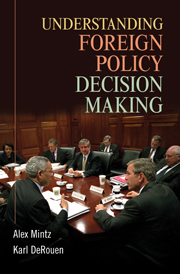Book contents
- Frontmatter
- Contents
- Acknowledgments
- PART ONE INTRODUCTION
- PART TWO THE DECISION ENVIRONMENT
- 2 Types of Decisions and Levels of Analysis in Foreign Policy Decision Making
- 3 Biases in Decision Making
- PART THREE MODELS OF DECISION MAKING
- PART FOUR DETERMINANTS OF FOREIGN POLICY DECISION MAKING
- PART FIVE MARKETING FOREIGN POLICY
- PART SIX CONCLUSION
- Appendix: Foreign Policy Simulation and Exercise
- References
- Index
3 - Biases in Decision Making
Published online by Cambridge University Press: 05 June 2012
- Frontmatter
- Contents
- Acknowledgments
- PART ONE INTRODUCTION
- PART TWO THE DECISION ENVIRONMENT
- 2 Types of Decisions and Levels of Analysis in Foreign Policy Decision Making
- 3 Biases in Decision Making
- PART THREE MODELS OF DECISION MAKING
- PART FOUR DETERMINANTS OF FOREIGN POLICY DECISION MAKING
- PART FIVE MARKETING FOREIGN POLICY
- PART SIX CONCLUSION
- Appendix: Foreign Policy Simulation and Exercise
- References
- Index
Summary
One of the main problems that leaders may encounter in crises is their tendency to be influenced by biases and errors in decision making because of cognitive limitations (Forman and Selly 2001). In fact, decision making for most complex, crucial foreign policy decisions takes place under constraints of information-processing limitations (ibid.). Biases often lead to misperception. Leaders see the world in ways that are subconsciously filtered by previous beliefs and experiences. In his seminal study of bias and misperception, Robert Jervis (1976) argues that decision makers generally do not perceive the world accurately and that we can understand and identify the sources of the misperception. Biases are listed in Table 3.1.
Saddam Hussein's misperceptions following Iraq's invasion of Kuwait in 1990 provide a textbook example (Mingst 2002). Saddam likely perceived that the United States would not react too strongly to the invasion, a perception based on a meeting he had with U.S. Ambassador April Glaspie. Many contend that Glaspie signaled to Saddam that the United States would not intervene in the border dispute between Kuwait and Iraq.
Saddam also might have expected that the Arab world would unite behind him as he tried to make Israel a party to the conflict. He might well have perceived that the world was focused on events in Europe as the Cold War was ending and the Soviet Union was breaking apart.
- Type
- Chapter
- Information
- Understanding Foreign Policy Decision Making , pp. 38 - 54Publisher: Cambridge University PressPrint publication year: 2010

